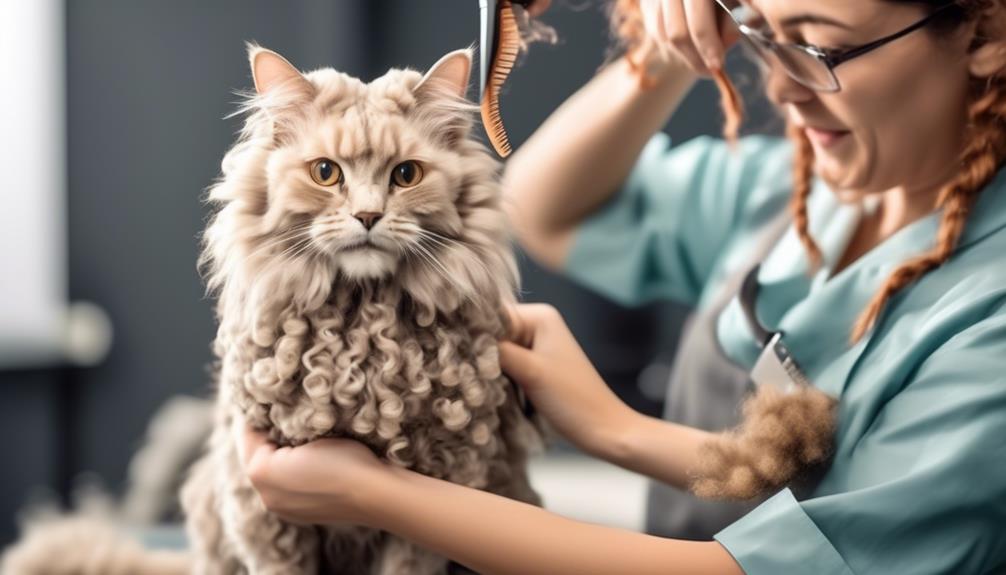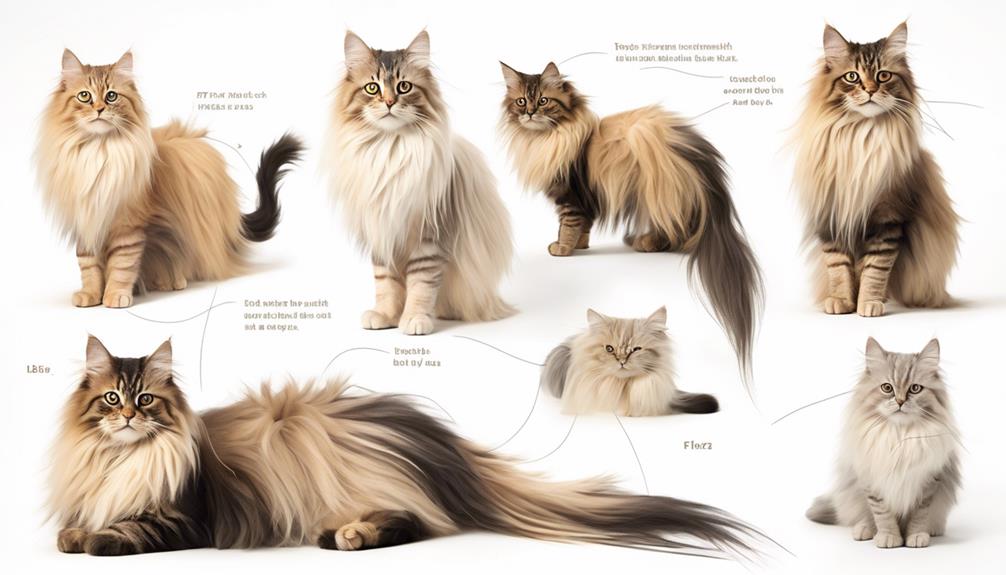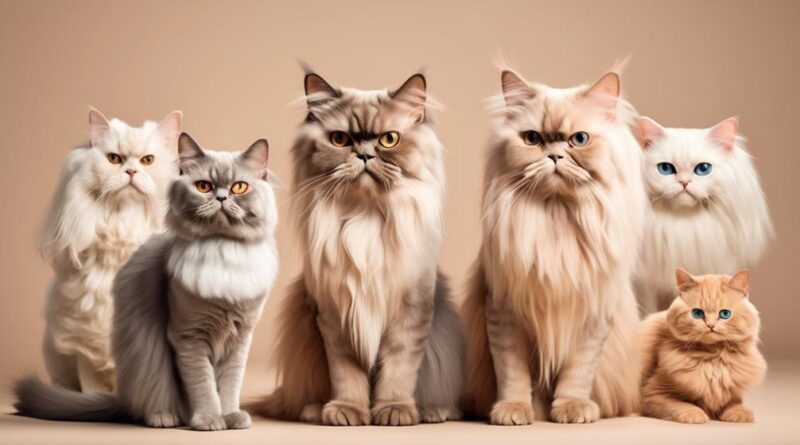What Determines Cat Grooming Needs for Various Breeds?
Imagine brushing your hand over a sleek, short-haired tabby, feeling the smoothness of its coat, and then running your fingers through the luxurious, flowing mane of a Maine Coon.
As a cat owner, you know that each breed has its own unique grooming needs, but have you ever wondered what factors determine these needs? Understanding the grooming requirements of different cat breeds is essential for maintaining their health and well-being.
From the amount of shedding to the texture of their fur, various factors play a role in determining the grooming needs of different cat breeds. But what exactly are these factors, and how do they impact your feline friend's grooming routine?
Short-Haired Breeds
When grooming short-haired breeds, regular brushing helps to minimize shedding and keep their coat smooth and healthy. Shedding frequency can vary among different short-haired cat breeds, but a consistent brushing routine using appropriate grooming tools such as a soft bristle brush or a grooming mitt can significantly reduce the amount of loose hair in your home. Short-haired cats generally shed less than long-haired breeds, but they still benefit from regular grooming to remove loose hair and distribute natural oils for a healthy coat.
In terms of seasonal coat care, short-haired breeds may experience increased shedding during seasonal changes. During these times, you may want to increase the frequency of brushing to manage the excess shedding.
Additionally, bathing frequency for short-haired cats is generally lower compared to long-haired breeds. Unless your cat gets unusually dirty or encounters a specific situation that requires bathing, a short-haired cat may only need a bath a few times a year.
Long-Haired Breeds
Long-haired cat breeds require regular grooming to prevent matting and tangling of their fur. Coat maintenance is essential for long-haired breeds such as the Maine Coon, Persian, and Ragdoll. Their luxurious coats are prone to matting if not brushed frequently. To maintain their coat's health and beauty, you should brush them at least a few times a week, using a comb or a slicker brush to remove loose hair and prevent tangles. It's important to start grooming these breeds from a young age to get them accustomed to the process.
Shedding control is another crucial aspect of caring for long-haired breeds. While all cats shed, long-haired cats may require more frequent brushing to minimize shedding around the house. By brushing them regularly, you can help reduce the amount of loose hair they leave on your furniture and clothes. This also prevents hairballs, which long-haired cats are more prone to due to grooming their long coats. In addition to brushing, using a high-quality cat food and providing adequate hydration can also help manage shedding.
Regular grooming not only keeps their coat healthy but also provides an opportunity to check for any skin issues, lumps, or parasites. It's a good idea to establish a grooming routine and stick to it, as this will benefit both you and your feline friend in the long run.
Curly-Coated Breeds

Grooming needs vary among cat breeds. Long-haired breeds require regular maintenance to prevent tangles and matting, while curly-coated breeds also have specific grooming requirements. If you have a cat with a curly coat, it's important to understand the grooming tools and techniques that will keep their unique fur in top condition.
Here are some important tips for managing the grooming needs of curly-coated breeds:
- Grooming tools for curly coated breeds: Curly-coated cats benefit from regular brushing to prevent their fur from becoming matted. Invest in a high-quality slicker brush or a comb specifically designed for curly coats. These tools can help to remove loose fur and prevent tangles, keeping your cat's coat healthy and shiny.
- Managing shedding in curly coated breeds: Despite their curly coats, these breeds still shed, and managing the shedding is crucial. Regular grooming helps to remove loose fur and reduce the amount of hair your cat sheds around your home. Additionally, providing a balanced diet and ensuring your cat stays hydrated can also help minimize excessive shedding.
Hairless Breeds
Regularly moisturizing the skin of your hairless cat is essential to maintain their overall health and comfort. Hairless breeds, such as the Sphynx, Donskoy, and Peterbald, require special attention when it comes to skincare. Without fur to protect their skin, hairless cats are more susceptible to dryness, sunburn, and other skin issues. To ensure your hairless cat's skin remains healthy, consider using a gentle, hypoallergenic moisturizer specifically formulated for cats. Regular moisturizing helps to keep their skin hydrated and prevents irritation.
In addition to moisturizing, sun protection is crucial for hairless breeds. Just like humans, hairless cats can get sunburned, especially in areas with intense sunlight. When taking your hairless cat outside, consider using pet-safe sunscreen on exposed areas, such as the ears and nose. It's important to choose a sunscreen that's specifically designed for cats to avoid any potential toxicity from ingredients that are safe for humans but harmful to felines. Additionally, providing shaded areas for your hairless cat to rest in during sunny days can help minimize their exposure to harmful UV rays.
Hairless cats have unique grooming needs, particularly when it comes to skincare and sun protection. By regularly moisturizing their skin and providing sun protection, you can help keep your hairless cat comfortable and healthy. Always consult with a veterinarian for specific skincare recommendations tailored to your hairless cat's individual needs.
Double-Coated Breeds
Double-coated breeds require special attention when it comes to maintaining their fur and skin health. These breeds have a dense, insulating undercoat and a longer protective topcoat, which means they have specific grooming needs to keep their coats healthy and free from mats and tangles.
Here's what you need to know about grooming double-coated breeds:
- Shedding Patterns: Double-coated breeds often have heavy shedding seasons, usually in the spring and fall, to prepare for the changing temperatures. During these times, regular brushing is essential to remove the loose undercoat and minimize shedding around your home. Understanding your cat's shedding patterns can help you prepare for and manage excessive hair in your living space.
- Undercoat Maintenance: The undercoat of double-coated breeds requires special attention. Regular brushing not only helps to reduce shedding but also prevents mats and tangles from forming in the dense undercoat. Using a de-shedding tool or a slicker brush can effectively remove loose fur and prevent the undercoat from becoming matted.
- Bathing Considerations: While some cats may not enjoy water, bathing double-coated breeds can help remove loose fur and reduce shedding. However, it's important to use a cat-specific shampoo and to dry your cat thoroughly after the bath to prevent any skin issues.
- Professional Grooming: Seeking professional grooming services for double-coated breeds can be beneficial, especially during heavy shedding seasons. Professional groomers can help with undercoat maintenance, mat removal, and overall coat health.
Single-Coated Breeds
Single-coated breeds generally require less frequent brushing and grooming compared to their double-coated counterparts. Their shedding patterns are generally less intense, making grooming a simpler task. Breeds such as the Siamese, Bengal, and Russian Blue fall into this category. Their short, sleek coats shed minimally and usually don't require extensive grooming to manage. However, even though single-coated breeds shed less, regular grooming is still important to minimize hairballs and keep their coat in good condition.
When it comes to grooming frequency, single-coated breeds typically need brushing about once or twice a week. This helps to remove loose hairs and prevent matting. Using a soft-bristle brush or a grooming glove can effectively remove loose fur and distribute natural oils throughout the coat. Additionally, regular grooming sessions provide an opportunity to check for any skin issues, lumps, or bumps that may require veterinary attention.
It's important to note that while single-coated breeds generally require less grooming, individual cats may have specific needs based on their coat texture and length. Some single-coated breeds, like the Cornish Rex, have unique fur that may need more frequent grooming to keep it in top condition. Always consider the specific characteristics of your cat's coat when determining the appropriate grooming routine.
Breeds Prone to Matting

Breeds prone to matting require regular grooming to prevent tangles and knots from forming in their coats. Without proper care, their fur can become matted, leading to discomfort and potential skin issues. To manage tangles in cat fur and prevent matting, consider the following tips:
- Regular Brushing: Breeds such as Maine Coons, Persians, and Ragdolls are prone to matting due to their long and thick fur. Brushing your cat's coat 2-3 times a week with a suitable brush or comb can help prevent tangles from forming.
- Special Attention to Problem Areas: Pay extra attention to areas where matting is likely to occur, such as behind the ears, under the armpits, and around the tail. Regularly combing these areas can help prevent mats from developing.
- Professional Grooming: For breeds highly prone to matting, consider professional grooming every 4-6 weeks. Professional groomers have the expertise and tools to manage and prevent matting effectively.
- Quality Diet and Hydration: A well-balanced diet and proper hydration contribute to healthy skin and coat, reducing the likelihood of matting. Consult with your veterinarian to ensure your cat's nutritional needs are met.
Breeds With Special Grooming Needs
To ensure that your cat's grooming needs are met, understanding the specific requirements for different breeds is essential.
When it comes to breeds with special grooming needs, shedding patterns and coat texture play a significant role. Breeds such as the Persian, Maine Coon, and Ragdoll have long, thick coats that require regular grooming to prevent matting and tangles. These breeds are known for their luxurious coats, but they also shed more than short-haired cats, so frequent brushing is necessary to minimize loose fur around your home.
On the other hand, breeds with short, dense coats like the Siamese, Burmese, and Russian Blue also have specific grooming needs. Despite their shorter fur, these breeds shed seasonally, and regular grooming helps to remove loose hair and reduce the risk of hairballs. Their coat texture may also require a different grooming approach, such as using a rubber brush to remove dead hair more effectively.
For breeds with special grooming needs, it's essential to establish a grooming routine that aligns with their shedding patterns and coat texture. This may include daily brushing for long-haired breeds and weekly grooming sessions for short-haired breeds.
Frequently Asked Questions
Are There Any Specific Grooming Techniques That Can Help Reduce Shedding for Long-Haired Breeds?
To help reduce shedding in long-haired breeds, proper brushing and trimming are essential. Additionally, consider their diet and supplements. By incorporating these grooming techniques and nutritional aspects, you can effectively manage shedding in your cat.
Do Certain Breeds Require More Frequent Grooming Due to Their Activity Level or Outdoor Exposure?
Certain breeds may require more frequent grooming due to their activity level and outdoor exposure. Regular grooming can help manage shedding and keep their coat healthy. It's important to consider each breed's specific needs.
What Are the Best Tools and Products for Managing Tangles and Mats in Curly-Coated Breeds?
To manage tangles and mats in curly-coated breeds, the best tools and products are detangling brushes and high-quality conditioning products. Regular grooming helps prevent matting and ensures proper care for your cat's curly coat.
Are There Any Health Conditions That May Affect the Grooming Needs of Hairless Breeds?
If your cat is a hairless breed, skin health plays a big role in grooming needs. Environmental factors like sun exposure can affect grooming requirements. Regular baths and moisturizing can help maintain healthy skin and prevent potential issues.
How Can I Best Manage the Seasonal Shedding of Double-Coated Breeds?
To manage seasonal shedding in double-coated breeds, brush your cat regularly using appropriate grooming tools. Adjust grooming frequency based on seasonal changes. Use deshedding tools to remove loose fur and prevent matting. This helps maintain a healthy coat.
Conclusion
So, now you know that cat grooming needs can vary greatly depending on the breed. Whether they've short or long hair, curly coats, are hairless, or have double or single coats, each breed has its own unique grooming requirements.
Some breeds may be prone to matting and others may have special grooming needs. Understanding your cat's breed and its specific grooming needs is essential for keeping your feline friend looking and feeling their best.
